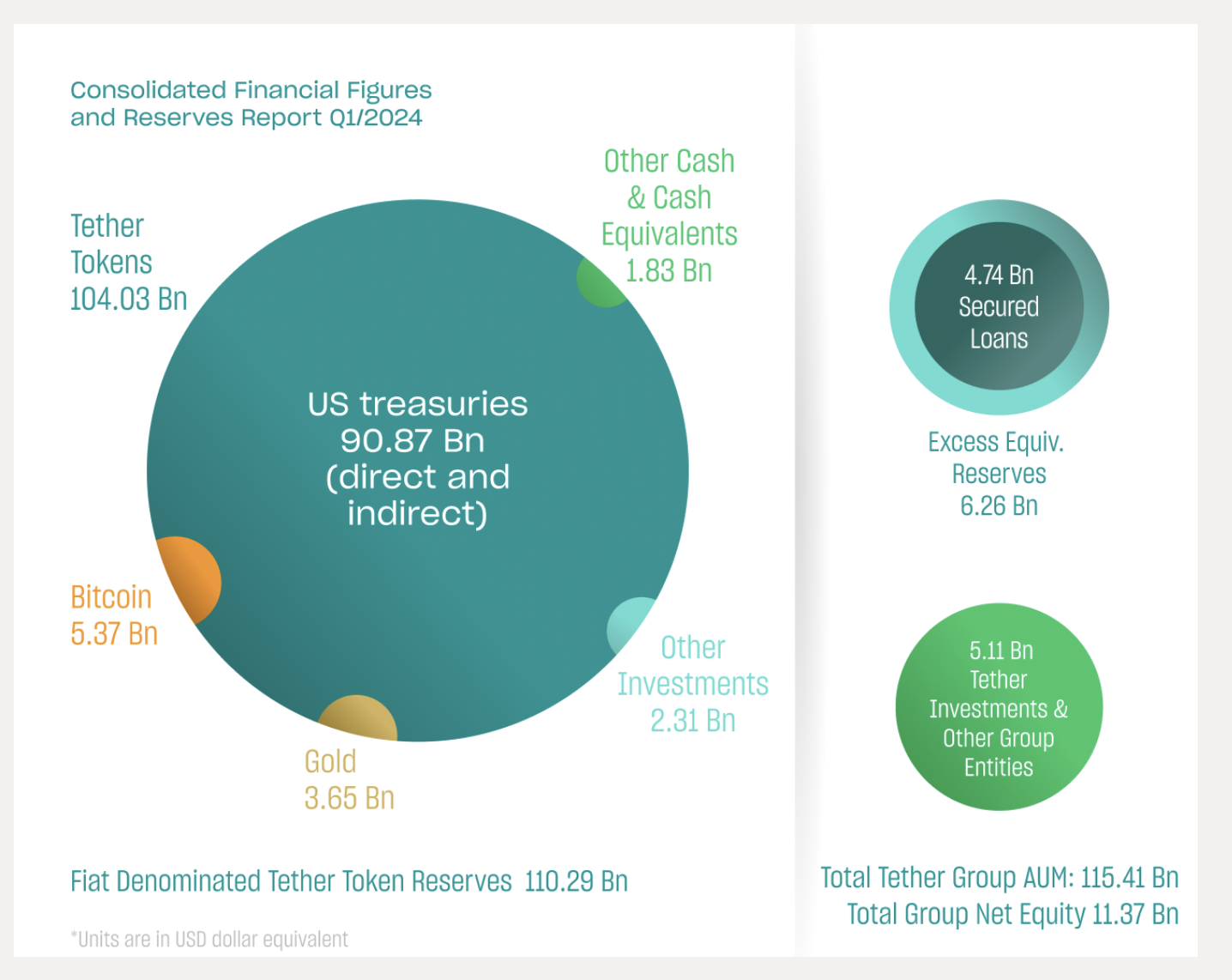Could Tether’s USDT collapse trigger the greatest crypto crash ever? With mounting concerns and speculation, it’s time to ask if your investments are safe from this looming threat.
The importance of Tether (USDT), as the largest stablecoin provider in the crypto market, in providing liquidity and stability cannot be overstated.
With a market cap of about $112 billion, Tether’s USDT is over three times bigger than its closest competitor, Circle’s USDC, which has a market cap of about $32 billion.
However, Tether has faced several concerning allegations over the years. Critics have questioned the transparency and backing of USDT, pointing to issues like insufficient reserves and the lack of proper audits. These concerns have made many in the crypto space wary.
On June 24, Tether announced that it would stop minting USDT on the Algorand (ALGO) and EOS (EOS) blockchains as part of a “strategic transition to prioritize community-driven blockchain support.”
While Tether will continue redeeming the stablecoin on these two chains for the next 12 months, new USDT will no longer be minted there.
On June 20, Peter Brandt, a well-known trader who has previously expressed concerns about Tether, issued some concerning predictions regarding its future.
Brandt believes that Tether is headed for disaster, echoing the sentiments of other critics who foresee critical issues with USDT in the future.
Let’s investigate the allegations against USDT, the reasons behind its recent strategic decisions, and whether a collapse is possible in the future.
USDT’s chaotic journey in the crypto market
Tether (USDT), originally named Realcoin, was launched in 2014 by Brock Pierce, Reeve Collins, and Craig Sellars under the company Tether Limited and was quickly rebranded.
Tether was introduced as a stablecoin pegged to the US dollar, with each USDT token purportedly backed 1:1 by reserves. However, Tether’s journey has been fraught with challenges.
From the start, Tether operated opaquely, raising concerns early on. Between 2017 and 2018, Tether’s market supply surged from approximately $10 million to $2.8 billion, sparking debates over the authenticity of its reserves and its transparency.
In 2018, Tether’s price briefly dropped to $0.88, inciting fears regarding its stability and reserve backing. Consequently, its market dominance declined from nearly 94% at the start of the year to about 74% by the end of 2018.
Despite these issues, Tether surpassed Bitcoin (BTC) in trading volume in 2019, cementing its vital role in the crypto ecosystem and drawing intense regulatory scrutiny.
In 2021, the New York Attorney General sued Tether and its sister company, Bitfinex, revealing that Tether had loaned $850 million from its reserves to cover Bitfinex’s losses. This lawsuit, which settled without an admission of wrongdoing, did little to silence the critics.
In 2023, The Wall Street Journal reported that Tether Holdings had used fake invoices and contracts to circumvent banking regulations, further damaging its credibility.
Over the years, the company has also faced allegations of market manipulation and links to illicit activities like money laundering and sanctions evasion.
Although Tether has increased its holdings of US Treasury Bills and has made attempts to enhance transparency by publishing reserve breakdowns and undergoing attestations, these actions have not completely dispelled doubts, as critics still question the transparency of Tether’s reserves, which previously consisted largely of commercial paper.

Meanwhile, Tether reported a record $4.52 billion profit in Q1 2024, with assets of $86.4 billion against liabilities of $83.2 billion. Tether now claims that 90% of its reserves are in cash and cash equivalents, mainly US Treasury Bills.
With a current market cap surpassing $112 billion, Tether dominates the stablecoin market. Yet, this dominance comes with the risk that any potential collapse could largely impact the entire crypto market.
Rising concerns for Tether
Amid a change in the regulatory factors, Tether, despite being the most widely used stablecoin, is facing growing concerns, especially in the European Union (EU).
In March 2024, crypto exchange OKX announced it would cease support for USDT trading pairs for users in the European Union and European Economic Area (EEA).
OKX stated that this move was to focus on euro-denominated liquidity. While USDT remains available for deposit, withdrawal, and over-the-counter (OTC) trading, it is no longer available for direct trading against crypto assets other than USDC and the euro.
This decision aligns with the EU’s new regulatory framework, known as the Markets in Crypto-Assets (MiCA) regulation, set to come into full force by the end of 2024.
MiCA requires stablecoin issuers to be regulated as electronic money institutions, a classification that many stablecoins currently offered in Europe do not meet.
Meanwhile, on June 18, cryptocurrency exchange Uphold notified its European users that it would delist six popular stablecoins, including USDT, starting July 1.
Uphold cited compliance with MiCA as the reason for this change. Users were instructed to convert their holdings into other cryptocurrencies before the deadline, after which the exchange would automatically convert the stablecoins into USDC.
Other major exchanges, such as Binance and Kraken, have also begun reviewing their stablecoin policies to comply with the new regulations.
Binance, for instance, has categorized its stablecoins into “regulated” and “unauthorized” under MiCA but has yet to finalize which stablecoins will continue to be supported.
Tether’s removal from trading pairs in the EU raises questions about its future as well as its legitimacy as a stablecoin in the region.
Could USDT collapse?
A look at the TerraUSD (UST) collapse offers a historical tale. TerraUSD was an algorithmic stablecoin designed to maintain its peg to the US dollar through a combination of algorithms and incentives involving its sister cryptocurrency, Luna.
In May 2022, UST faced a severe depegging from the US dollar, leading to a collapse. The system failed to stabilize UST, causing panic and a massive sell-off that wiped out billions of dollars in value from the crypto market.
If USDT were to face a similar fate, the consequences could be far more severe due to its larger market presence and the fact that it is widely used across various exchanges and platforms.
Meanwhile, regulatory pressures are increasing, as seen with the EU’s MiCA regulations, which could lead to more stringent oversight and potential legal issues for Tether.
Additionally, the lack of transparency about its reserves continues to be a major concern. If it is revealed that Tether’s reserves are insufficient or if it fails to comply with new regulations, a collapse could become a reality.
While Tether has managed to overcome challenges in the past, the potential for collapse remains a serious concern that the crypto community cannot afford to ignore.
What would happen if USDT eventually collapses?
If Tether (USDT) were to collapse, the impact on the crypto market would be catastrophic. USDT is the backbone of many trading pairs and provides essential liquidity across numerous exchanges. As the most traded stablecoin, its collapse would send shockwaves throughout the entire crypto ecosystem.
Firstly, the immediate effect would be a drastic reduction in market liquidity. USDT accounts for a large portion of daily trading volumes.
As of June 26, USDT is the most traded crypto asset, with a volume of nearly $60 billion, surpassing BTC, which has a trading volume of nearly $43 billion. Moreover, there is a tenfold difference in their market caps: BTC is around $1.12 trillion, while USDT is approximately $112 billion. This highlights the gravity of the potential impact a USDT collapse could have.
Tether printed $80 billion in USDT tokens throughout 2020 and 2021 alone, suggesting its massive influence. If USDT were to disappear, the liquidity it provides would vanish, causing prices to plummet across the board.
Moreover, investors would scramble to exit their positions, leading to a massive sell-off and a steep decline in crypto asset values. Vitalik Buterin has previously referred to Tether as a “ticking time bomb” for Bitcoin, hinting at the potential for widespread market disruption.
Secondly, exchanges that heavily rely on USDT pairs would face operational disruptions. Many centralized exchanges use USDT as the primary stablecoin for trading pairs.
A collapse would force these platforms to halt trading, restrict withdrawals, and enter emergency maintenance. Smaller exchanges, in particular, might not survive the liquidity crunch and could go bankrupt, resulting in users losing access to their funds.
Moreover, the collapse of USDT would erode trust in stablecoins and the entire crypto market, casting doubt on the reliability of other stablecoins, like USDC and DAI. This loss of confidence could deter new investors from entering the market and push existing ones to withdraw their funds.
Shielding your portfolio from Tether risks
Protecting yourself from a potential USDT collapse requires proactive measures and diversification. Here are some strategies to safeguard your investments:
- Diversify your stablecoin holdings: Instead of relying solely on USDT, consider holding a mix of other stablecoins like USDC, DAI, or BUSD. These alternatives have different reserve backing and regulatory compliance, reducing the risk associated with a single stablecoin.
- Use multiple exchanges: Spread your assets across several reputable exchanges to mitigate the risk of any single platform facing liquidity issues or going bankrupt in case of a USDT collapse. Ensure that these exchanges have strong security measures and are compliant with regulations.
- Stay informed and updated: Keep abreast of the latest news and developments regarding Tether and other stablecoins. Regulatory changes, legal issues, or market movements can provide early warning signs of potential trouble.
- Consider fiat on ramps and off ramps: Maintain access to fiat currency options on exchanges. This allows you to quickly convert your crypto assets to fiat in case of market instability. Look for exchanges that offer seamless fiat transactions and have strong banking relationships.
- Hold a portion of assets in cold storage: For long-term holdings, consider keeping a portion of your crypto assets in cold storage wallets. This reduces exposure to exchange-related risks and ensures the safety of your funds.
- Hedge with other Assets: Diversify your overall investment portfolio by including traditional assets such as stocks, bonds, and commodities. This can help balance the risk and provide stability in case of crypto market disruptions.
Disclosure: This article does not represent investment advice. The content and materials featured on this page are for educational purposes only.




